

What Is Wirearchy ? » Wirearchy. Over the past 10+ years, ask thousands of people have asked me “what is wirearchy?”
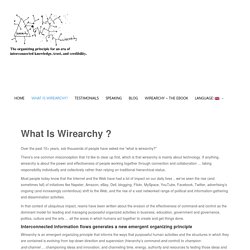
Complex adaptief systeem. Complex systems. Complex systems present problems both in mathematical modelling and philosophical foundations.
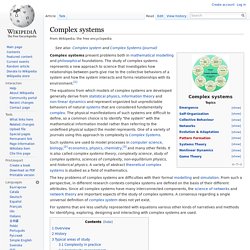
The study of complex systems represents a new approach to science that investigates how relationships between parts give rise to the collective behaviors of a system and how the system interacts and forms relationships with its environment.[1] Such systems are used to model processes in computer science, biology,[2] economics, physics, chemistry,[3] and many other fields. It is also called complex systems theory, complexity science, study of complex systems, sciences of complexity, non-equilibrium physics, and historical physics.
A variety of abstract theoretical complex systems is studied as a field of mathematics. The key problems of complex systems are difficulties with their formal modelling and simulation. Overview[edit] Complex adaptive system. They are complex in that they are dynamic networks of interactions, and their relationships are not aggregations of the individual static entities.

They are adaptive in that the individual and collective behavior mutate and self-organize corresponding to the change-initiating micro-event or collection of events.[1][2] Overview[edit] The term complex adaptive systems, or complexity science, is often used to describe the loosely organized academic field that has grown up around the study of such systems. Complexity science is not a single theory— it encompasses more than one theoretical framework and is highly interdisciplinary, seeking the answers to some fundamental questions about living, adaptable, changeable systems. The fields of CAS and artificial life are closely related. The study of CAS focuses on complex, emergent and macroscopic properties of the system.[3][11][12] John H. General properties[edit] Characteristics[edit] Robert Axelrod & Michael D. Modeling and Simulation[edit] Www3.nd.edu/~gmadey/Activities/CAS-Briefing.pdf. Guidelines for Group Collaboration and Emergence.
I’m in the middle of taking a course on Virtual Learning Environments (syllabus here), and reading a few chapters from Adaptive Software Development by Highsmith.

It approaches the team-building and collaboration process from the perspective of complex adaptive systems theory, and contains some interesting insights in evolutionary development and creating environments where emergence can occur. Where is the Edge of Chaos? Learning is Connecting. “Education over the Internet is going to be so big it is going to make email usage look like a rounding error.” – John Chambers 1999 Cisco’s CEO, John Chambers, was right, but not the way most people understood it at the time.
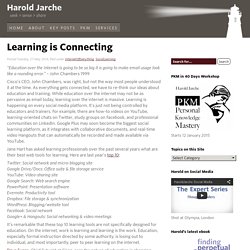
As everything gets connected, we have to re-think our ideas about education and training. While education over the internet may not be as pervasive as email today, learning over the internet is massive. Learning is happening on every social media platform. It’s just not being controlled by educators and trainers. Jane Hart has asked learning professionals over the past several years what are their best web tools for learning. It’s remarkable that these top 10 learning tools are not specifically designed for education. Mastering the Internet of Everything. In a recent interview, John Chambers, CEO of Cisco, stated that the major hurdle for the Internet of Everything is the underlying architecture or it will not happen, as too much effort will have to be spent on systems integration.
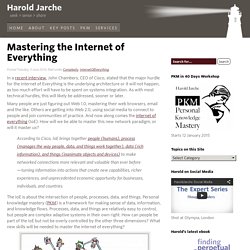
As with most technical hurdles, this will likely be addressed, sooner or later. Many people are just figuring out Web 1.0, mastering their web browsers, email and the like. Negotiating between chaos and project deadlines. Informal learning is a business imperative. In Part 2 of Social Learning doesn’t mean what you think it does, my colleague Jane Hart uses a very helpful diagram created by a previous colleague of mine, Tom Gram: Tom Gram’s diagram [reproduced below] shows that “most work requires a combination of knowledge work and routine work.

These characteristics of jobs and work environments call for different approaches to training and development.” Life in Perpetual Beta. One definition for a Beta release is, “A version of the vendor’s software that is given to selected installations prior to the product becoming generally available.

This version is often not free of defects.” I can relate to the second sentence when I think of my personal and professional life being in a state of continuous Beta releases. This perspective has been my norm for a few years, particularly since I’ve become a free-agent and have to do everything, including my own tech support. PKM: a node in the learning network. Hyperlinks subvert hierarchy, or, in other words, digital networks enable multiple connections, so organizational communications are no longer just vertical.
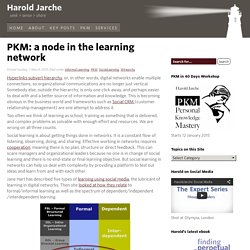
Somebody else, outside the hierarchy, is only one click away, and perhaps easier to deal with and a better source of information and knowledge. Critical thinking in the organization. Even the mainstream training field is realizing that reduced layers of bureaucracy mean decision-making gets pushed down the organization chart.
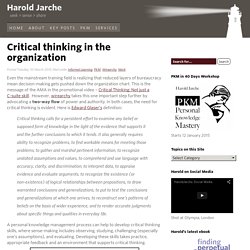
This is the message of the AMA in the promotional video – Critical Thinking: Not just a C-suite skill. However, wirearchy takes this one important step further by advocating a two-way flow of power and authority. In both cases, the need for critical thinking is evident. Here is Edward Glaser’s definition: Critical thinking calls for a persistent effort to examine any belief or supposed form of knowledge in the light of the evidence that supports it and the further conclusions to which it tends. A personal knowledge management process can help to develop critical thinking skills, where sense-making includes observing, studying, challenging (especially one’s assumptions), and evaluating. Several web tools can be used to develop critical thinking skills; the foundation of PKM:
Making Collaboration Work. Leadership and engagement for improvement in the NHS. The NHS faces a number of challenges – driving up quality of care, making significant productivity gains, ensuring the government’s reforms work. To meet these challenges, individuals and organisations need to rethink the way in which power and responsibility are shared within teams and organisations and across the health and care system. Leadership and engagement for improvement in the NHS: together we can makes the case for engaging staff, patients and boards and for building relationships across systems of care. Building on the work of The King's Fund's 2011 Leadership Commission, the 2012 review has taken evidence from a number of national and international experts.
Coping with the end of reductionalist leadership in a complex world – insights from complexity and social movement. The King’s fund in the UK is an important think tank commenting on UK health policy. Last week it published its thoughts on leadership and engagement. As part of this the King’s Fund commissioned a report from the Centre for Health Enterprise at Cass Business School in London of which I am part. PKM — Personal Knowledge Mastery. Seek > sense > share PKM is a unified framework of individually constructed enabling processes to help each of us make sense of our world, work more effectively, and contribute to society.
PKM means taking control of your professional development, and staying connected in the network era, whether you are an employee, self-employed, or between jobs. Personal – according to one’s abilities, interests & motivation. (not directed by external forces)Knowledge – understanding information and experience in order to act upon it. In an increasingly complex world. Enterprise knowledge sharing requires trusted relationships. As the economy gets more networked, open organizations are becoming a necessity. Businesses are increasingly dependent on complex social interactions. Products are becoming services, as we can see with web apps, software, and even books. Variety and diversity. Why do we need social business? It's not complicated, you see. When Bayer’s Material Sciences Division decided to become more collaborative, they realized that the main challenge in promoting knowledge-sharing across organizational boundaries is culture.
They deployed the software platform (IBM Connections) without any formal training, saying that when the tool is simple to use, people focus on collaboration, not the software. Their solution was simple. I know few enterprise software projects that go without a hitch. These are complicated tools and even after implementation most people only use a few functions from the wide array that are available. As complexity increases, and we keep adding new tools to the workplace, the simpler the tool, the easier it will be to implement, especially since the lifespan of our knowledge tools keeps getting shorter. Managing On The Edge Of Chaos. By Jay Deragonon 08/06/2012. Complex is the new normal.